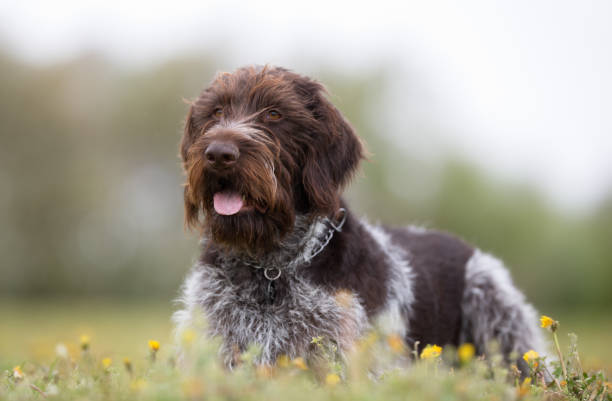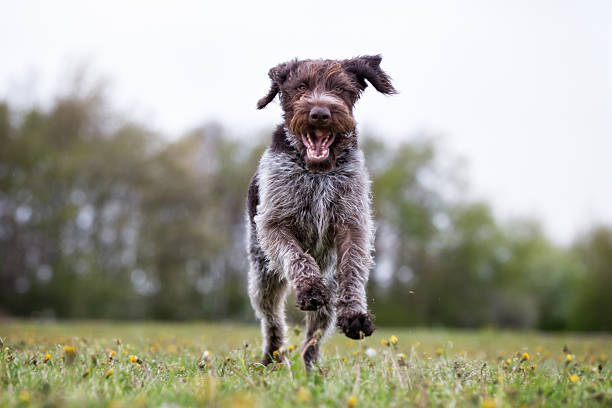German Wirehaired Pointer (GWP)

Breed History:
The German Wirehaired Pointer (GWP) was developed in Germany during the late 19th and early 20th centuries by hunters who wanted a tough, all-purpose hunting dog that could work in dense cover, cold water, and varied terrain. German sportsmen sought a breed that could track, point, retrieve, and also serve as a loyal household companion.
To create the GWP, breeders crossed several established breeds, including the German Shorthaired Pointer, Stichelhaar, and Wirehaired Pointing Griffon. The goal was to retain the GSP’s versatility while adding a protective, weather-resistant wire coat, more resilience in rough terrain, and greater independence in the field.
By 1928, the breed was standardised in Germany and quickly gained popularity among European hunters. The GWP made its way to the United States in the 1920s, where it has been used extensively for upland birds, waterfowl, and even large game tracking. Today, it remains a preferred gundog for hunters who need one dog for all tasks, combining sharp instincts with rugged endurance.
Considering adopting a pointer breed? Check out our page "How to look after a Pointer" detailing what to consider before adopting and our recommended products.
|
Gender |
Height |
Weight |
|
Male |
60-67 cm |
27-32 kg |
|
Female |
56-62 cm |
22-27 kg |
Size: Medium to Large
Life Expectancy: 12–14 years

Breed Appearance:
The German Wirehaired Pointer is a sturdy, athletic dog with a distinctive wire-textured coat and a bold, noble look. Its harsh outer coat and dense undercoat protect it from thorns, brambles, and cold water.
Key features include a bushy beard and eyebrows, a broad head, and drop ears. The coat colours are typically liver, liver and white, or roan with ticking or patches. The tail is usually docked (where legal), and the breed has a muscular build suited for long working days.
Breed Type – Versatile Gundog:
The GWP is a true multipurpose field dog, excelling at pointing upland game, retrieving waterfowl, and tracking wounded animals. It’s known for being independent, driven, and extremely durable, yet also loyal and affectionate with its family.
More rugged than its shorthaired cousin, the GWP is ideal for hunters who need one dog to do it all—across water, fields, and forests.

Training:
Highly intelligent and eager to work, but can be strong-willed:
-
Responds well to positive reinforcement and structure
-
Needs early socialisation to avoid becoming overly suspicious of strangers
-
Can be stubborn if bored or under-challenged
-
Strong prey drive—requires firm recall training
-
Thrives with owners who hunt, hike, or work outdoors
Ideal for experienced handlers who enjoy training and outdoor activities.
Health & Care:
Generally a hardy breed, but may be prone to:
-
Hip and elbow dysplasia
-
Eye issues (cataracts, progressive retinal atrophy)
-
Von Willebrand’s disease (a bleeding disorder)
-
Ear infections, especially in working dogs
-
Bloat (gastric torsion) in deep-chested dogs
Regular checkups, a balanced diet, and proper ear cleaning help prevent issues.

Living Conditions:
Best suited to active, rural, or suburban homes:
-
Needs a fenced yard and regular exercise
-
Can adapt to indoor living if properly stimulated
-
Not suitable for apartment living or inactive households
-
Bonds closely with family—doesn’t like long isolation
-
May not mix well with small pets unless socialised early
They thrive when given a job or a daily physical and mental outlet.
Exercise:
High stamina and drive:
-
Requires 1.5–2+ hours of daily activity
-
Enjoys running, tracking, swimming, and retrieving
-
Excellent for hiking, hunting, agility, or search-and-rescue
-
Needs structured training and mentally engaging work
Without sufficient exercise, they may become destructive or anxious.
Grooming:
Low to moderate grooming needs:
-
Brush 2–3 times a week to prevent matting
-
Hand-strip coat if showing; otherwise, occasional trimming is fine
-
Clean ears weekly, especially after water exposure
-
Routine nail trimming and dental care
Sheds moderately and is relatively low-odour for a hunting breed.

Advantages:
-
Tough, adaptable, and highly versatile hunting dog
-
Intelligent and eager to work
-
Loyal, protective, and affectionate with family
-
Great nose and stamina in all environments
-
Distinctive appearance with low grooming needs
-
Excels in hunting, agility, obedience, and active lifestyles
Disadvantages:
-
Needs lots of daily exercise and mental stimulation
-
Can be stubborn or dominant if untrained
-
May be aloof or territorial with strangers
-
Strong prey drive—may chase cats or wildlife
-
Not suited for apartments or low-activity homes
-
May become destructive or vocal if bored

